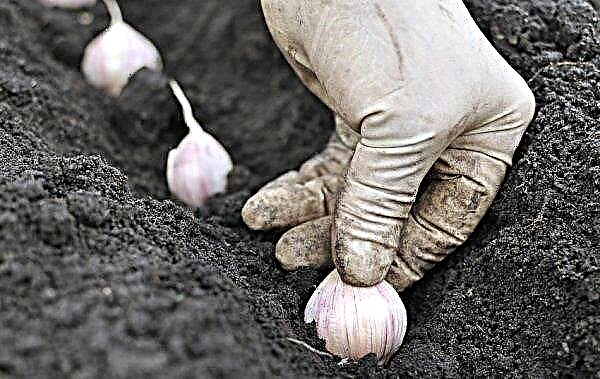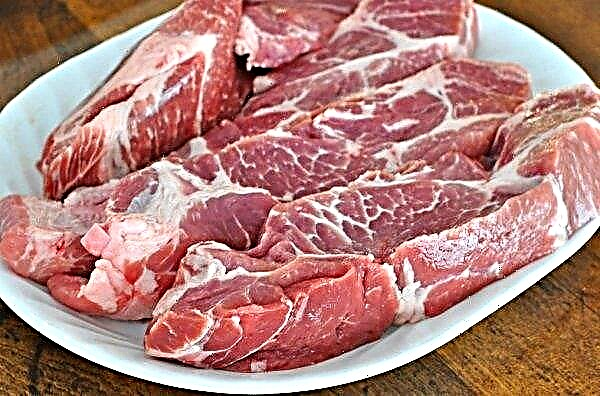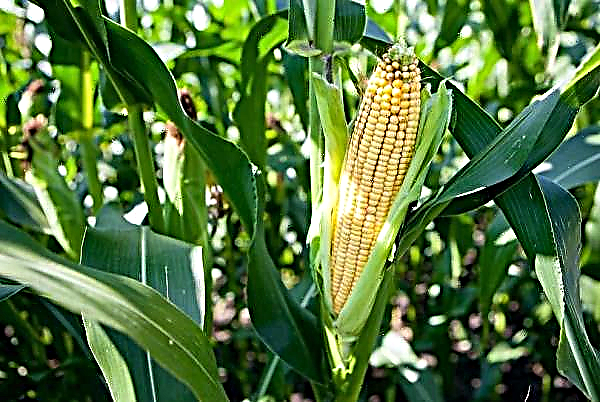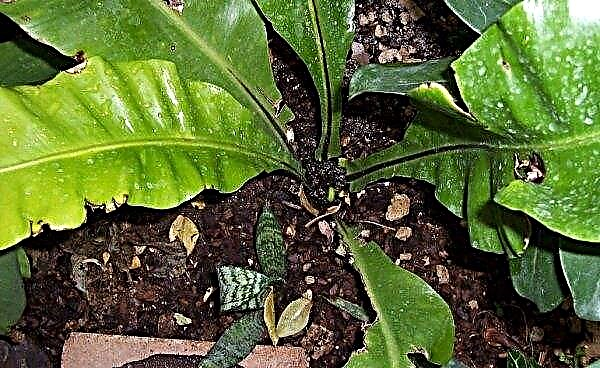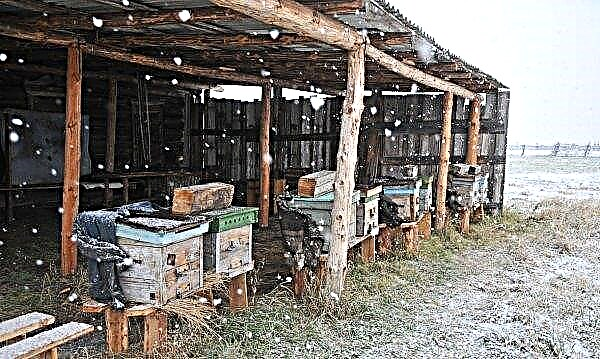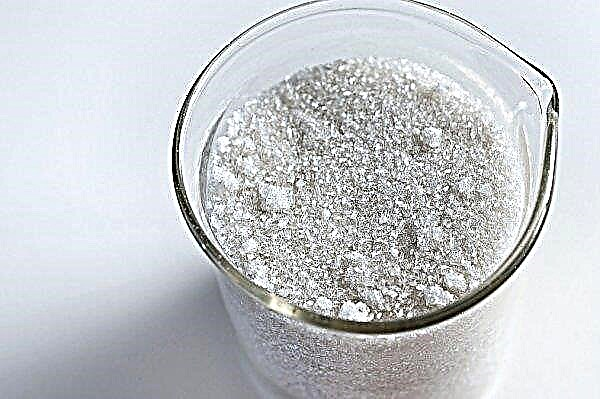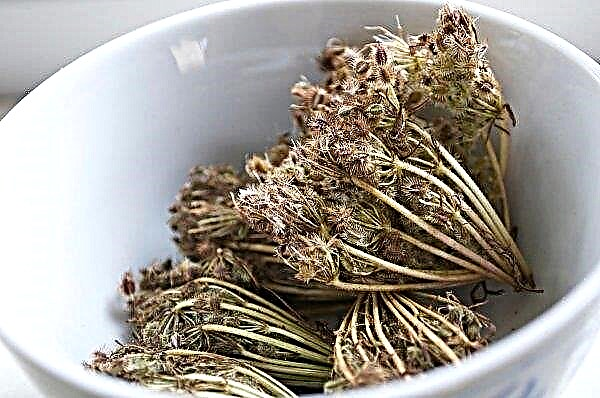Cauliflower is rightfully considered one of the most healthy and vitamin-rich vegetables, so many gardeners prefer to grow it on their sites. In general, this culture is easy to care for, however, it is very sensitive to a number of diseases, and pests are not averse to feasting on its foliage and inflorescences. What can destroy the cauliflower crop and how to prevent it will be discussed below.
Common cauliflower diseases and their treatment
Most often, cauliflower is affected by various diseases, some of which can be harmful to the plant. It is important for the gardener to know their main signs in order to take the necessary measures in a timely manner.
Did you know? In 2014, the British gardener Peter Gleizbrook, keen on growing record-breaking vegetables, was able to cultivate a giant cauliflower, whose weight exceeded 27 kg.
White rot
One of the unpleasant diseases of the fungal nature is white rot. It occurs on already harvested vegetables in violation of storage rules, in particular, when the permissible moisture level is exceeded (above 80%). A white fluff resembling mold forms on the surface of the head of the head, mucous coating can be seen on the leaves and stalk.
You can fight the disease, observing the basic rules:
- maintaining optimal humidity and air temperature 0 ... + 1ºС;
- room treatment with potassium permanganate solution;
- careful selection of cabbage, without defects and signs of the disease.
Kila
It is considered one of the most fatal diseases for culture. The disease is caused by a fungus and affects the root system: nodes are formed on the roots that disrupt the normal metabolic process, as a result of which the vegetable first stops growing, then its leaves turn yellow, after which the plant dies.
To prevent the spread of infection, you need:
- remove diseased plants;
- treat the soil with a solution of Bordeaux liquid 1% or any agricultural fungicide, according to the instructions;
- remove weeds regularly.
Important! Re-planting cauliflower in the area where keel disease has previously spread is possible only after 5 years.
Blackleg
The threat to young plants, and especially to seedlings, is another fungal disease called the black leg. The stalk of young seedlings as a result of the process of decay is covered with black spots, becomes thin, as a result, seedlings die. At the same time, there is a risk of infection of nearby plants.
The following measures will help in the fight against the black leg:
- to process the soil of beds with fungicide (for example, 1% solution of Fitosporin);
- the seeds are soaked before sowing in a pale pink solution of potassium permanganate for 15-20 minutes;
- the wells from which the diseased plants were removed, pour potassium permanganate solution.
Gray rot
This disease affects not only cauliflower, but also white cabbage, its appearance can be noticed during storage of vegetables. At first, characteristic gray spots appear on the head, then the process of decay begins, a gray fluff and mucous plaque are formed.
To avoid the appearance of this ailment, you need to properly store the harvest:
- disinfect shelves, walls and containers in the room with a solution of potassium permanganate;
- maintain the temperature regime within 0 ... + 1ºС.
Mosaic
This is a dangerous viral disease that is transmitted through the juice of infected plants or carried by aphids. The disease usually makes itself felt after transplanting seedlings into beds, when the immunity of seedlings is weakened. On the foliage of the vegetable, the veins turn yellow, it stops growing. As a result of the development of the disease, leaflets are folded, spots form on them and eventually they fall.
To prevent the spread of the mosaic virus, you must:
- remove diseased specimens by carefully digging them from the ground, being careful not to damage the roots;
- disinfect seeds before planting, soaking in hot water 50ºС for 20 minutes, then drying them;
- maintain the temperature regime for seedlings + 18 ... + 20ºС, conduct hardening a week before transplanting into open ground;
- regularly remove weeds from the site.
Important! Excessive feeding of cabbage with nitrogen-containing fertilizers can provoke the development of the disease.
Downy mildew
Fungal disease, manifested by the appearance of yellow spots and whitish plaque on the foliage. The plant slows growth, the disease affects the stems, testes, black or brown foci appear on them. Many people wonder if such a vegetable can be eaten: if the disease has not affected the inflorescences, and they have not become stained, then the product will not bring harm, otherwise you can’t eat cabbage.
For the prevention of the disease you need:
- be sure to process the planting material: soak the seeds for 15-20 minutes in hot water, then for 3 minutes in cold;
- carry out fungicidal tillage with Fitosporin solution, according to the instructions.
Mucosal bacteriosis
One of the most common ailments that affect directly the inflorescences of the cauliflower head. A bacterial infection appears at first in the form of decay of the base of the leaves, then it infects the inflorescences themselves, as a result of which black spots appear on the head, an unpleasant putrefactive smell emanates from the vegetable.
You can fix the problem by eliminating the provoking factors:
- avoid waterlogging of the soil;
- remove weeds in a timely manner;
- carry out pest control (cabbage fly is especially dangerous);
- disinfect the vegetable storage area.
Vascular bacteriosis
A common disease, characteristic of cauliflower, manifests itself at any stage of plant development and causes significant damage to the crop. It affects the vascular system of a vegetable. It is most often found in regions with a rainy, humid climate. External manifestations are noticeable on the leaves: the onset of the disease is characterized by the appearance of light yellow dots along the edges of the foliage, which gradually grow to the center, the veins turn black. The foliage begins to fade and crumbles.
The fight against bacterial infection is effective only in the form of prevention:
- the area where infected vegetables grew needs to be treated with colloidal sulfur at a concentration of 0.4%, while the next planting of cabbage can be done no earlier than 3 years later;
- soak the seeds before sowing seedlings in the Agat-25 solution (5 g of the preparation per 1 liter of water, soak the seeds for 2-3 hours).
Fusarium wilt
An incurable disease caused by a fungus that retains its activity in the soil for a long time. The defeat of the disease causes the leaves to turn yellow. Gradually, brown or dark brown dots appear on the emerging yellowness, which grow to extensive spots. At the final stage of the disease, the leaves completely fall off.
This disease is not subject to treatment, only symptomatic measures are possible:
- the affected heads of cabbage destroy;
- the soil is sprayed with copper sulfate at the rate of 5 g of chemical per bucket of water.
Cauliflower pests and control
In addition to diseases, cauliflower growing in open ground in a summer cottage is threatened by various pests, while some of them are so inconspicuous that they are found only after causing serious damage to the crop. What are these parasites, and how to deal with them, an urgent issue for many gardeners.
Slug
These are parasites similar in appearance to a snail; they can be found on any succulent garden plant. They eat juices, gnawing foliage, stems and fruits of vegetables. Cauliflower is often affected by slugs, especially the lower leaves. There are no specific means for the destruction of the pest, and single individuals are not capable of causing significant damage to the crop. It is easiest to remove them mechanically by manually collecting from plants. Since slugs start up in a humid environment, in order to avoid their appearance, it is necessary to observe the watering regime and to prevent stagnation of water around the cabbage.
There are no specific means for the destruction of the pest, and single individuals are not capable of causing significant damage to the crop. It is easiest to remove them mechanically by manually collecting from plants. Since slugs start up in a humid environment, in order to avoid their appearance, it is necessary to observe the watering regime and to prevent stagnation of water around the cabbage.
Aphid cabbage
Perhaps one of the most formidable pests for cabbage, the insect rapidly multiplies and feeds on the sap of the plant. In this case, the foliage suffers in the first place, it curls and becomes covered with a pink coating.
Timely measures taken can prevent the death of vegetables:
- weed removal and site cleaning;
- digging the soil before planting cauliflower;
- the affected leaves are treated with a soap solution;
- use insecticidal agents for spraying (for example, "Karbofos").
Did you know? Sometimes aphids can be beneficial. In some cultures, juice contains too many sugars, which interferes with normal photosynthesis. Aphids, eating this juice, eliminates the excess, normalizing metabolic processes in the plant.
Cruciferous fleas
Dangerous parasites that feed on cabbage. Especially common on young plants. They are small black bugs that gnaw through a lot of small holes in the leaves, as a result of which the foliage dies. The pest is able to quickly destroy all planted cabbage.
To stop the parasite invasion, you need to follow simple recommendations:
- destroy cruciferous weeds;
- dig up the soil regularly;
- in the heat to cover the landing with dense material;
- plant tomato bushes around cauliflower, the smell of which scares off cruciferous fleas.
Spring cabbage fly
Dangerous pest laying larvae around the stem and into the soil. As they grow, the larvae begin to eat greens and stalks of cabbage and other plants.
The following methods have been successfully used to combat the parasite:
- hilling out of cabbage at least 1 time per month;
- digging soil;
- pollination of plants with wood ash;
- use of insecticides for irrigation (for example, 0.2% Karbofos solution), according to the instructions.
Caterpillars
Among gardeners, one can often hear about the so-called cabbage worms, however, with a detailed study of the problem, it can be understood that the vermin found by the worm has nothing to do with it, it is one of the varieties of caterpillars that parasitize cauliflower. Moths and white butterflies, which lay larvae directly on the foliage of the plant, most seriously harm the vegetable. As they grow older, the larvae turn into caterpillars, which first eat leaves, and then get to inflorescences.
The key to a successful fight against the parasite will be the implementation of simple tips:
- regular inspection of the plant, collection and destruction of laid eggs and adults from leaves;
- subsequent spraying of cabbage with low-toxic insecticides (for example, "Dipel"), according to the instructions.
How to process cauliflower from pests and diseases
In order to preserve the harvest of cauliflower and effectively protect it from diseases and parasites, it is necessary not only to properly organize the care of the crop, but also to responsibly choose the means and preparations for processing.
Most often, gardeners use popular and affordable means:
- To overcome bacterial diseases and their prevention, the soil is treated with a solution of colloidal sulfur of 0.4% (average consumption of 5 g per 1 m² plot).
- Fungal diseases are successfully overcome thanks to the use of fungicidal agents. Most often, Bordeaux 1% is used to spray the beds. In addition, the Fitosporin biological product is widely used for soil and seed cultivation, according to the attached instructions.
- In pest control, as a rule, industrial insecticides are used to spray plants and soil. The most popular remedy among gardeners is the Bankol drug, a universal broad-spectrum insecticide. The solution is prepared in accordance with the manufacturer's instructions.
- Nor can one ignore folk remedies. For example, to destroy aphid larvae or other insects, a strong solution of laundry soap (100 g of soap per 1 bucket of water) is perfect. To overcome infectious diseases, liming of the soil is carried out by applying ash at the rate of 2 kg of ash per 1 m² of planting).
So, the main diseases and pests affecting cauliflower have been described above. This allows us to conclude that this plant is susceptible to a large number of diseases, however, the method of combating them is reduced to strict adherence to cultivation agricultural techniques, monitoring and application of standard preventive measures, such as quality soil care and regular inspection. Compliance with these simple rules will avoid problems and at the end of the season to harvest a rich harvest of healthy vegetables.

